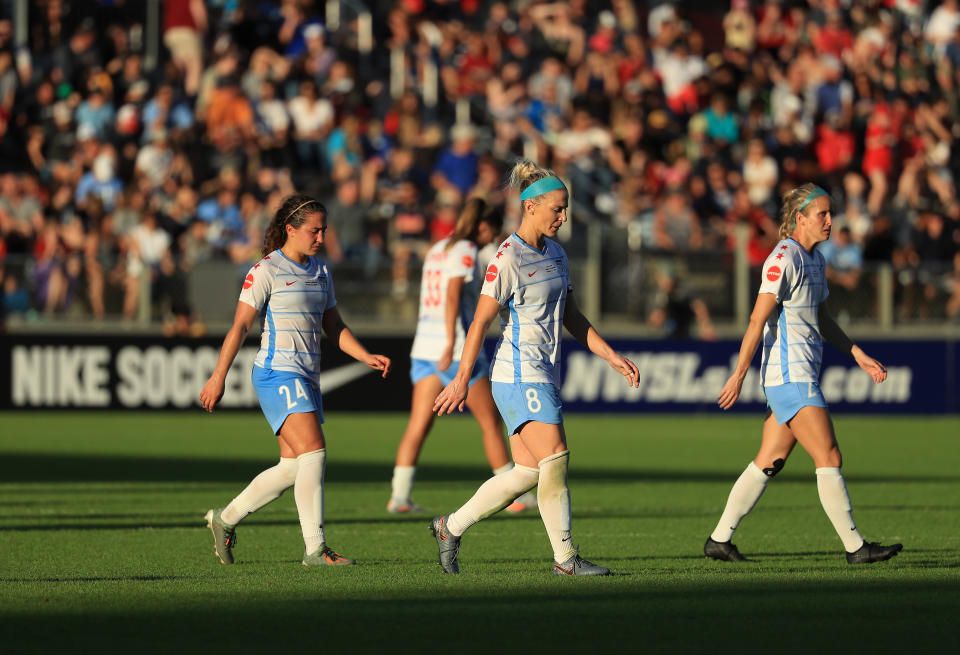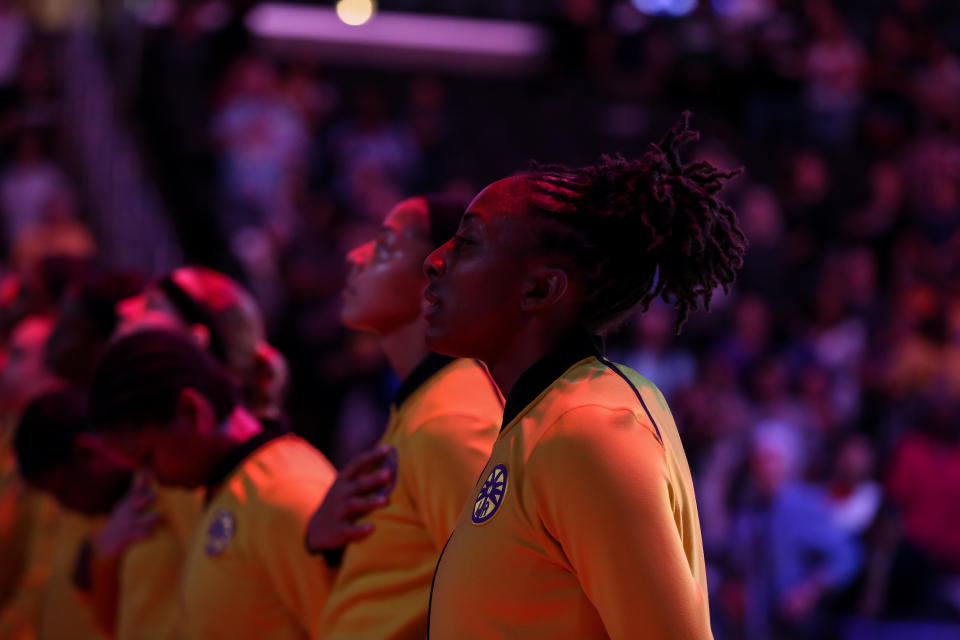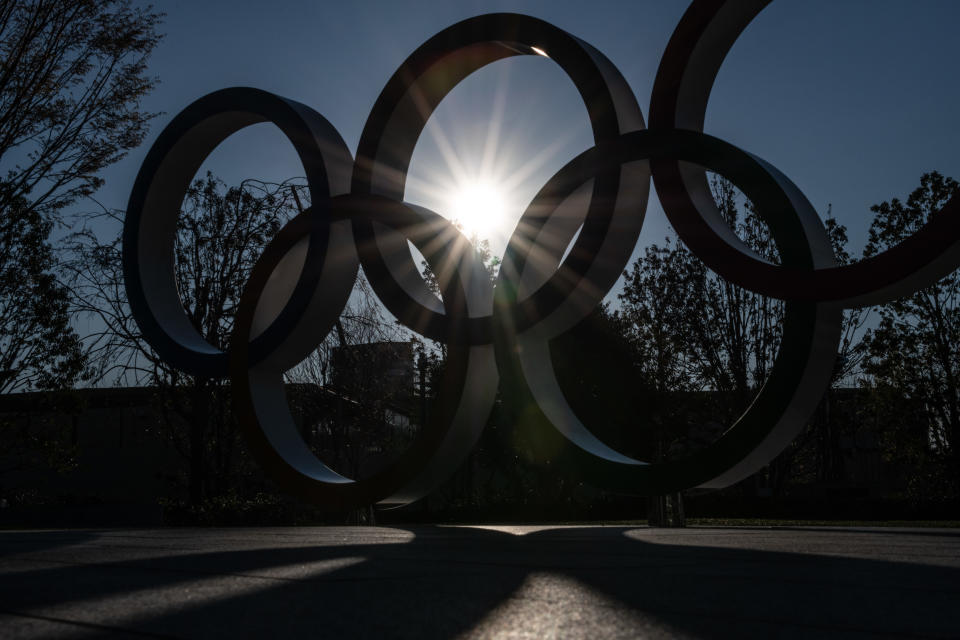No one doubts NFL and NBA can rebound from coronavirus. For women's sports leagues, it's a different story
Several weeks ago, it appeared 2020 was poised to be the best year in women’s sports ever.
The WNBA had signed a landmark collective bargaining agreement that the league’s commissioner hailed as “a big bet on women.” The NWSL had hired a new commissioner with the chops to capitalize on a global boost of interest in women’s soccer after the 2019 World Cup. And the Olympics were set to serve as a platform to tell the stories of female athletes at the top of their craft.
But suddenly, all that momentum has been forced to a grinding halt. No one knows when the COVID-19 pandemic will end and sports will resume, but the longer the momentum in women’s sports is kept at bay, the bigger the concern grows that it will go away altogether.
After all, no one is actually worried the NFL or the NBA could end up on shaky ground, or that their players will have problems making ends meet. But in women’s sports, where leagues are typically young and fledging and some athletes are paid very little, the effects of the pandemic will be more acutely felt.
That’s why, from across the spectrum of women’s professional sports, from soccer to softball, basketball to hockey, stakeholders say they are prepared to fight their way through this — even if there’s no denying that it’ll be difficult.
“We’re used to adversity in women’s sports,” National Women’s Hockey League commissioner Dani Rylan told Yahoo Sports. “We work so hard for every partner, for every dollar, for every sponsor that comes on board, so that we’re just as committed now more than ever to fight for those dollars.”

Immediate impact of coronavirus on women’s sports
Lisa Baird, the new commissioner of the NWSL, started her job March 10. Two days later, she had announced a training moratorium that essentially canceled the pro soccer league’s preseason.
“That was my first two days,” Baird said. “So what’s gone out the window? Any notion of a 30-day plan or a 100-day plan, except for the basics. In the short term, I don’t have a playbook for the NWSL having to navigate the safety issues of COVID-19 and trying to redo the schedule when every other league is trying to redo their own schedule.”
The seven-year-old NWSL, like other leagues, has attempted to set a resume date — it was supposed to kick off in April and is now targeting June — but with each passing day, a precise return looks less and less likely.
For now, NWSL players are still being paid and having their contracts honored as they sit holed up in the year-round in-market housing, which is being provided for the first time this year. But with the league significantly increasing compensation starting this season, paying the players well into the year without expected revenue could create a precarious situation.
The WNBA, meanwhile, was supposed to start on May 15 and that has been pushed back to an unknown date. A college draft will be conducted remotely online Friday, without the usual fans or fanfare.
Some players spent the offseason overseas supplementing their income, which should help if the pandemic seriously impacts the WNBA’s plans. But because COVID-19 affected other parts of the world earlier than the U.S., some players are already feeling the effects of a work stoppage.
Nneka Ogwumike, the head of the WNBA Players Association and a forward for the Los Angeles Sparks, says many WNBA players are in different circumstances, and there are more questions than answers right now.
“Everyone’s dealing with their own problems,” she said. “It even got to a point overseas where players waited to the last minute to travel back to ensure they could get paid as much as their contract would allow, and you might have players entering arbitration to get their money. I wouldn’t say anyone is better or worse off.”

The National Pro Fastpitch softball league canceled games scheduled for April. The league’s college draft has also been canceled because the NCAA season was sidelined by the pandemic, too.
The NWHL, which isn’t expected to resume until October, has more time to see how this crisis plays out. The hockey league was forced to postpone its championship, the Isobel Cup, which was supposed to be held March 13.
The focus now has shifted from ending the 2019-20 season to preparing for the season ahead.
“We feel great about the upcoming season. We have six months to continue to build, and as of today we’ve already announced contracts with 10 players for the next season,” Rylan says. “We have about a dozen more that we’re currently reviewing and hope to announce in the coming weeks.
“Obviously, there are challenges none of us have ever envisioned and we’re mindful of that, but we're in a position to offer opportunities for women to play professional hockey and for staff to be paid to be a part of this growing initiative.”
Longer-term concerns for women’s sports
The longer the postponements drag on, however, the bigger the impact will be.
For leagues like MLB, which has billions of dollars tied up in broadcast rights, simply getting games on television may be the most important business concern. That’s why the league had reportedly considered playing games in front of no fans in a single location.
But for leagues like the NWSL and the NWHL, ticket sales are a key driver of revenue. Both leagues have broadcast deals with Twitch, and the NWSL also has a deal with CBS, but the prospect of playing an entire season without fans may not be so appealing.
Then, there are sponsorships.
Last season, the NWHL introduced a 50/50 revenue-sharing model between the league and players, which resulted in a 26 percent increase in player salaries that had previously maxed out around $15,000. Rylan said the league front office and the players union are continuing to work together on securing new partnerships, but she admits that even six months out from the start of the season, it may be tougher this year.
For the NWSL, Baird is still having the conversations she planned to have with potential partners when she was hired. But now it’s about finding a way to have a season in 2020. The league is smaller than MLS, its male counterpart, but that makes it more adaptable in the face of unexpected obstacles.
“We have a strategy that our owners embraced, and we developed a strategy quickly because we’re small, so we can be very nimble and very responsive,” Baird said. “The key is really flexible thinking.”
No one seems to want to discuss it at this point, but the possibility looms: There’s a chance that 2020 seasons will never happen.
While President Donald Trump has been antsy to get Americans back into public spaces, infamously saying Easter Sunday would be a “beautiful time” for churches to be filled, scientists and medical experts have been more circumspect. In Santa Clara, California, authorities have said “we’d be lucky” to have sports back by Thanksgiving.
The rapid spread of COVID-19 stateside seems to be slowing, but only because large swaths of the country have been isolated in their homes. The decision to loosen such guidelines is a serious move, especially when an explosion of cases in Bergamo, Italy, has been traced to a soccer match that one doctor called a “biological bomb.”
Sports are secondary to public safety — everyone Yahoo Sports spoke to for this story agreed. But that means a full 2020 without sports can’t be ruled out.
What happens in that scenario?
“I honestly couldn’t tell you,” Ogwumike said. “That’s definitely something that the PA and the league would have to discuss. It’s definitely on people’s radars, but obviously it’s the very last-case scenario that we hope to have to deal with.”
The looming Olympics
The 2020 Olympics were going to be an especially big moment for softball. After years of sitting on the sidelines, 2020 was set to be softball’s return to the Olympic Games.
Some players had come out of retirement to compete in the National Pro Fastpitch (or NPF), the top women’s league in the United States, and earn low- to mid-four figures just to train to be an Olympian.
But now the Olympics are on hold, pushed back to 2021. And even then, there’s a worry they may never be staged at all.

For softball, which is not on the docket for the 2024 Olympics, that would be a major setback. A big chance to attract new fans would vanish.
“You can bet that in Olympic year, the sport of softball will roll out a long coattail for everyone to jump on,” NPF commissioner Cheri Kempf said. “That’s why it was important for us to play a season in an Olympic year. Whether they win gold, silver or bronze, there are going to be some Americans that will stand out and have worldwide recognition. Now that’s on hold.”
The Olympics figured to help launch a new softball league called Athletes Unlimited, which is set to begin in August. Plans to launch that league are still moving forward, Kempf said.
In soccer, the Tokyo Games were supposed to be the second of a one-two punch of the World Cup and Olympics being played in back-to-back years. The NWSL seemed to be in position to capitalize thanks to the arrival of Baird, the new commissioner who knows how to build brands and sign deals.
Now, it’s unclear what an Olympic bump will look like, if it happens at all. But Baird is doing what she was hired to do: build a league that will be sustainable well into the future.
“Women’s soccer has this incredible chance in the United States,” Baird said. “Not only do you have a World Cup coming to the U.S. in 2026. Two years, you have the Olympics coming. The game-changer is when you’re the host country. It’s been documented time and time again what it does for youth becoming interested in soccer and new companies coming in to do new partnerships and the amount of media attention soccer will get.
“We had an incredible year as a sport in 2019 with the World Cup and what I consider to be the best women’s soccer league with the best players, and it’s up to us to build that bridge and growth trajectory into the long term.”
If the Olympics do proceed in 2021, it could be worth the wait.
In the past, NBC has devoted more of its airtime to telling the stories of female Olympic athletes. In light of the hardship they’ll endure because of this pandemic, which figures to be more severe than their male counterparts, there will be plenty of stories to tell.
The event would still offer a boost to sports like basketball, soccer and softball, just a year later. And it would be an even more powerful statement.
“There was so much to lose by still trying to have it at the same time that we might actually gain so much more by having it a year after all of this,” Ogwumike said, “assuming we’ll be able to come together as a community at the Olympics to truly symbolize the unity of the people in the world after we’ve dealt with something like this.”
Caitlin Murray is a contributor to Yahoo Sports and her book about the U.S. women’s national team, The National Team: The Inside Story of the Women Who Changed Soccer, is out now. Follow her on Twitter @caitlinmurr.
More from Yahoo Sports:

